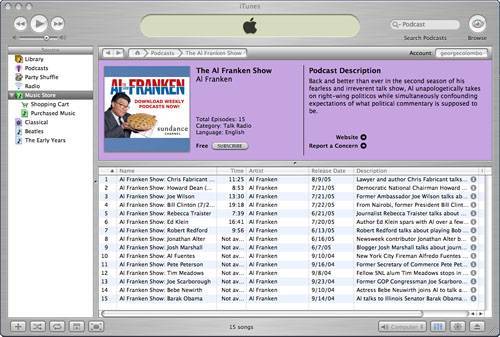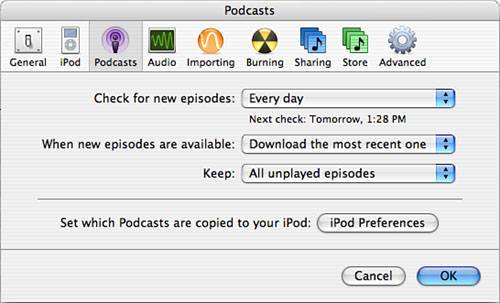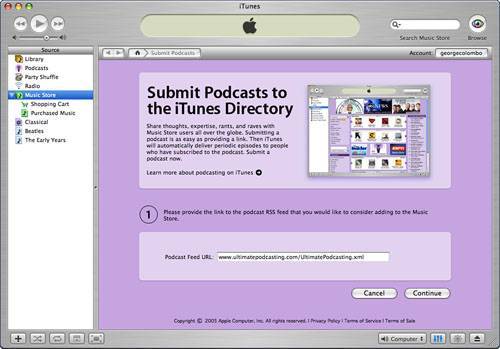Introducing iTunes 4.9
| In July of 2005, Apple fired the shot heard around the podcasting world when it introduced Version 4.9 of its popular iTunes software. That new version of iTunes became the first mainstream music management software to incorporate support for podcasting. (Podcasting support remains an integral part of iTunes with the release of iTunes 5.01, the most current version of the software as this book goes to press.) The significance of the iTunes announcement for podcasters can hardly be overstated. Apple legitimized podcasting, transforming it instantly from an intriguing technological curiosity into a mainstream medium. More importantly, it exposes podcasting to an audience that is orders of magnitude larger than ever before. Apple dominates the market for portable music players with its line of iPod players. In fact, most estimates of Apple's share of the market list it at approximately 70 percent, with its line of iPod players, and every single one of those iPod owners is using iTunes. For the purposes of navigation, iTunes treats podcasting as a cross between an audio book and its own musical genre. On the iTunes home page, you can navigate to the main podcast page from the Choose Store column on the left side of the page, as shown in Figure D.1. Figure D.1. Start exploring iTunes podcasts by selecting Podcasts from the Chose Store column on the left. (You can also select Podcasts from the Choose Genre pull-down menu. That selection will take you to iTunes Podcasting home page. From there, you can browse through thousands of podcasts to find and subscribe to the ones you're interested in. When the history of podcasting is written, the iTunes announcement will be seen as the new medium's first watershed event. While the sheer number of iTunes users is an important element in making this a milestone, it is certainly not the only one. iTunes Offers One-Click SubscriptionsApart from exposing podcasting to many, many more potential listeners, Apple also enhanced the user experience dramatically. The most important element of this transformation is the introduction of single-click subscriptions to podcasts. While the technological cognoscenti were able to navigate through the multi-step process of subscribing to a podcast, the average user often found the experience a bit intimidating. (If you refer to Chapter 1, "An Overview of Podcasting," you'll see what we mean!) Once you find a podcast you're interested in, iTunes reduces the subscription process to a simple single click of your mouse, as shown in Figure D.2. Figure D.2. Clicking the Subscribe button is all you need to do to begin you podcast subscription in iTunes. Just like dedicated podcatching software, iTunes allows you to manage the settings for your subscription. Podcast settings are accessed by a Settings button at the bottom of the iTunes window, allowing you to control how iTunes handles your podcast subscriptions, as shown in Figure D.3. Figure D.3. iTunes allows you to specify how you want the software to handle your podcasts. iTunes Allows Listeners to Manage Music and Podcasts from a Single ApplicationPrior to the release of iTunes 4.9, listeners needed to manage their podcast subscriptions with whichever podcatching software they were using, then import their podcasts into iTunes, a process that was not always seamless or thoroughly reliable. iTunes now allows listeners to manage their podcasts and subscriptions from a single interface, improving reliability and enhancing ease of use. Eliminating the need for multiple applications to manage podcasts and podcast subscriptions raises the ease-of-use bar dramatically for the entire podcasting industry. Getting Your Podcast into the iTunes DirectoryFortunately, Apple made it simple for you to use iTunes as a vehicle for distributing your podcast. In fact, submitting a podcast to iTunes is almost as easy as subscribing to one. From the main Podcast page on iTunes, simply select the Submit a Podcast link on the left side of the page. From there, iTunes will guide you through a series of steps that will allow you to submit your podcast to the iTunes directory, as shown in Figure D.4. Figure D.4. iTunes guides you through the steps you need to follow in order to submit your podcast. You'll need an iTunes account to submit your podcast, something you already have if you're an iTunes user. Once your podcast has been submitted, it will take a few days for it to appear in the iTunes directory. The Good News and the Bad NewsThere's no question about the fact that iTunes makes it easier than ever before for large numbers of listeners to find and subscribe to your podcast. It significantly reduces the technological barrier between you and your listeners. That's the good news. The bad news is that iTunes is not particularly geared toward supporting independent podcasts. Its slant is more toward podcasts from large media outlets, primarily radio content that has been re-purposed into podcast format. Another problem with iTunes is the fact that, while it makes it easier for the 70 percent of the market that uses iPods, it does not allow you to reach the 30 percent of the market that doesn't. While Apple's share of the MP3 player market remains high, that isn't a big issue. If non-iPod players ever start to erode Apple's market share, however, the dynamics of the situation will begin to change. Finally, you should be aware of the fact that Apple has chosen to use an RSS implementation that is slightly non-standard. If you use a third-party application or service such as FeedBurner or Feeder to generate your RSS feed, chances are that it's been updated to accomodate iTunes. If you're generating your own RSS feed, then you need to make sure it conforms to Apple's technical specifications for the feed. The current technical specs can be found here: http://phobos.apple.com/static/iTunesRSS.html The Bottom LineiTunes is a terrific place to list your podcast, and its support for podcasting is certainly a great thing for podcasting, in general. It's important, however, to keep iTunes in perspective and don't rely on it as the exclusive vehicle for your podcast. |
EAN: N/A
Pages: 167